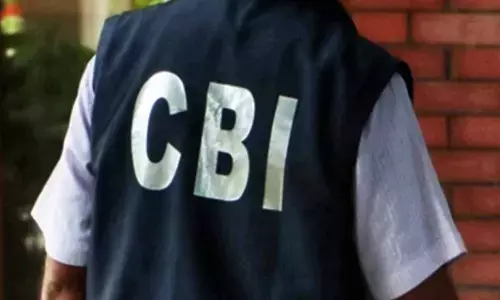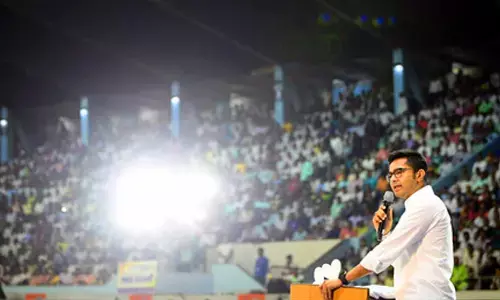Is Modi a risk worth taking?

K Ramachandra Murthy: Is Modi a Risk Worth Taking? he has the ability and vision to rise above the Hindutva agenda and build a strong and prosperous India.
I was one of those ‘pseudo secularists’ who entertained apprehensions about Narendra Modi, BJP’s PM candidate, allegedly a divisive personality, who would be a disaster. Having watched the election scene and the protracted campaign so far, I have been gradually persuaded to accept the idea of Modi as PM. True, he can be polarising, autocratic and hence dangerous. He can also prove the doomsayers wrong and surprise the nation pleasantly by emerging as another Atal Behari Vajpayee. If what he said in his interviews to news channels and newspapers in the run up to the elections is anything to go by, he has the ability and vision to rise above the Hindutva agenda and build a strong and prosperous India.

The election campaign underway has been unusual for more than one reason. Modi made it attractive and interesting by all means. He has proved to be far superior to all his rivals in style and substance. Priyanka Vadra may be better than her brother Rahul Gandhi but she is not a match to Modi. Had Modi been confined to Gujarat without being anointed as PM candidate by BJP president Rajnath Singh at the behest of the RSS, the BJP campaign would have been headed by either veteran leader LK Advani or Rajnath Singh. Any one of them would have made it routine or lackluster. Modi has made a lot of difference to the electioneering. We are not aware of the corporate houses that are backing him. But there seems to be no dearth of funds. The creative commercials aired by almost all the channels across the country and the advertisement published in newspapers are all very well produced. The campaign strategy has been well conceived. Modi changed his attire depending on the local customs- a turban in Punjab, headgear in northeast, Nehru jacket in UP, white kurta-pyjama in South Indian States. He changed the campaign themes according to the region and the people. Election Commission had afforded him the advantage of being everything to everyone by stretching the poll schedule for six weeks. The whole exercise was professional. He launched the campaign with creation of jobs, economic growth and governance as core issues of his agenda. The Gujarat strongman has the advantage of having a clever political operator in Amit Shah to use religious sentiments in a subtle way. Shah attains respectability as he was absolved by the CBI in Ishrat Jahan encounter case. In Faizabad, Modi invoked Ram Rajya from a stage which had Rama in the background. In West Bengal, Modi was seen supporting the Hindus among the Bangladesh refugees who have Durga Mata in heart and opposing the Muslims describing them as infiltrators and asking them to be ready with bistar packed to leave the country after May 16 when the election results would be declared. Modi and Mamata Banerjee together appear to have succeeded in polarising the voters in WB. At the time of filing nomination papers at Varanasi, Modi spoke of the call of Ganga Mata to be a candidate there. To counter a virulent attack by Priyanka who alleged that the BJP’s PM candidate was practising ‘neech rajniti (low-level politics)’, Modi dropped the ‘neech’ bomb. He asked the audience in Amethi if it is a sin to be born in a backward caste. “Is my rajniti ‘neech’ due to my ‘neech jati’, he thundered. Never mind the distortion of what Priyanka said. All is fair in war and election. Mayawati, chief of Bahujan Samaj Party (BSP), had to hurriedly hold a media conference to mount a fresh, severe attack on Modi for brandishing the BC card. Arun Jaitley, Modi’s right hand man, was quick in giving a retort to Maya blaming her for being apologist for the Congress.
Catering to a particular region is a phenomenon first experimented by YS Rajasekhara Reddy, Congress Chief Minister of AP, in 2009. In the first phase of polling he spoke as though he was not opposed to the creation of a separate State of Telangana. Soon after, he spoke at Nandyal in Kurnool district saying that any person from Seemandhra would need a passport to visit Hyderabad if the State is bifurcated. It was intended to win over Seemandhra people who were opposed to the division. YSR managed to win in both the regions. Chandrababu Naidu, chief of Telugu Desam Party (TDP) too used this stratagem by calling his approach to the Telangana question a ‘two-eye policy’. In contrast, YS Jaganmohan Reddy, president of YSRCP, abandoned Telangana as soon as AP Bifurcation Bill 2014 was passed by Parliament and concentrated on Seemandhra. It was a high risk game played by Naidu and Jagan and it remains to be seen what kind of dividends they would reap in general election as part of which polling took place in Seemandhra on Wednesday.
Narendra Modi had changed the character of the election from parliamentary to presidential. He is PM candidate as well as MP candidate not only in Vadodara and Varanasi from where he is contesting, but also in almost all the constituencies in the country. He made it a presidential election by being seen as virtual candidate in every Lok Sabha constituency. This trend also is not entirely new. When Indira Gandhi split the Grand Old Party before 1978 elections, people had voted for her in every Assembly constituency in AP. Non-entities put up by Dr Chenna Reddy, the then PCC(I) president, won over established candidates fielded by Jalagam Vengal Rao, Congress (R) Chief Minister of AP. Indira and Vajapayee were used as mascots of their parties. Regional parties like TDP, SP, BSP, DMK, AIADMK, RJD, JD(U) and BJD have the supreme leaders who canvass for all the candidates. The voters in Tamil Nadu vote either for Jayalalithaa or Karunanidhi. In UP the votes are cast either for Mulayam Singh or Mayavathi. In Seemandhra, voters had to choose between Naidu and Jagan. The candidates are not very important. But Modi is more than a mere symbol or a mascot.
Manmohan Singh may be incorrigibly mild and non-communicative. But he has been a no-nonsense development-oriented PM. But it has been a dull and drab decade. Rahul Gandhi does not inspire confidence that he can rule the country. He needs more time to cut his teeth and understand the intricacies of politics or he may have to give way to his sister. UPA-III, if at all, will be headed by either Rahul Gandhi or someone who is an appointee like Manmohan. It is not at all a good prospect.
Modi as a PM does not seem to be such a bad idea. It would be good if he gets a clear mandate to rule the country although my political sense tells me that he would not be able to get a majority on his own since the BJP’s catchment area is limited. The regional parties are too deeply entrenched to wish them away. For instance, Modi has to get more than 60 out of the 80 Lok Sabha seats in UP if he has to take BJP’s tally beyond 250 seats. BJP will have to increase its 2004 and 2009 total of 10 seats by six times. With the SP and BSP going strong, the target is out of the question whatever the English TV channels and their psephologists might say. But Modi’s failure in achieving the required numbers would mean instability. Many people believe that there is no alternative (TINA) to Modi. But some others believe that there are many alternatives (TAMA). If the second option is taken, there will be many leaders to select the PM from. Imagine a Mulayam Singh or Jayalalithaa or Naveen Patnaik or Mamata Bannerjee heading a Third Front(TF) or Federal Front(FF) government supported from outside by the Congress. It would not last one year. The economy that is being left behind by Manmohan Singh is not that bad. It has recovered a bit thanks to Finance Minister Chidambaram and RBI Governor Rajan. It would be ruined by the TF or FF experiment. In mid-term poll following the fall of the government, the same choice would be there before the voters. Is it not better to avoid the nightmare called TF of FF and go for Modi straightaway If Modi belies hopes and harps on the Hindutva agenda or anti-poor policies of reducing subsidies What if he suppresses dissent and acts as an autocrat What if the democratic institutions are stifled What would happen if clearances for mining proposals are granted without regard to environmental concerns Four decades ago the people of India fought against the emergency rule of Indira Gandhi. That was described as the second freedom struggle. If Modi creates an occasion for another struggle people would be ready to fight. It will be an opportunity to rededicate for the cause of independence and freedom. Either way, Modi is a risk worth taking.















